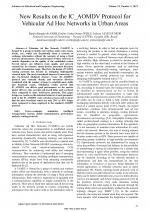| 3/2023 - 3 |
New Results on the IC_AOMDV Protocol for Vehicular Ad Hoc Networks in Urban Areasde ASSIS, D. R. |
| Extra paper information in |
| Click to see author's profile in |
| Download PDF |
Author keywords
computer simulation, intelligent transportation systems, mobile communication, performance analysis, routing protocols
References keywords
networks(16), routing(12), vehicular(11), communications(7), vanets(6), vanet(6), protocol(6), mobile(6), aodv(6), technology(5)
Blue keywords are present in both the references section and the paper title.
About this article
Date of Publication: 2023-08-31
Volume 23, Issue 3, Year 2023, On page(s): 21 - 28
ISSN: 1582-7445, e-ISSN: 1844-7600
Digital Object Identifier: 10.4316/AECE.2023.03003
Web of Science Accession Number: 001062641900003
SCOPUS ID: 85172330000
Abstract
A Vehicular Ad Hoc Network (VANET) is formed by a group of mobile and wireless nodes (cars, buses, trucks, etc), which can dynamically form a network to exchange information without the necessity of using a fixed network infrastructure. The performance of these networks is entirely dependent on the quality of the established routes. Several factors can influence route quality and network connectivity, for instance: speed, density, movement direction, and radio transmission range. Therefore, the design of VANET routing protocols has become an intriguing challengeable research topic. The newly introduced Improved Connectivity Ad Hoc On-Demand Multipath Distance Vector (IC_AOMDV) protocol uses vehicular density and movement direction (combined with the number of hops) to establish more stable and beneficial routes. Simulation results proved that IC_AOMDV can deliver good performance on the metrics packet delivery rate, average end-to-end delay and overhead, when compared to other well-known protocols. This paper brings new results on the statistical behavior of each parameter used in the IC_AOMDV route selection process and it shows that the most beneficial routes are only 20% to 30% longer when compared to those employed in the standard AOMDV protocol. |
| References | | | Cited By |
Web of Science® Times Cited: 1 [View]
View record in Web of Science® [View]
View Related Records® [View]
Updated 2 weeks, 5 days ago
SCOPUS® Times Cited: 1
View record in SCOPUS® [Free preview]
View citations in SCOPUS® [Free preview]
[1] Enhanced QL-Based Dynamic Routing Protocol for Urban VANETs, BUGARCIC, P., JEVTIC, N., MALNAR, M., STOJANOVIC, M., Advances in Electrical and Computer Engineering, ISSN 1582-7445, Issue 4, Volume 24, 2024.
Digital Object Identifier: 10.4316/AECE.2024.04003 [CrossRef] [Full text]
Disclaimer: All information displayed above was retrieved by using remote connections to respective databases. For the best user experience, we update all data by using background processes, and use caches in order to reduce the load on the servers we retrieve the information from. As we have no control on the availability of the database servers and sometimes the Internet connectivity may be affected, we do not guarantee the information is correct or complete. For the most accurate data, please always consult the database sites directly. Some external links require authentication or an institutional subscription.
Web of Science® is a registered trademark of Clarivate Analytics, Scopus® is a registered trademark of Elsevier B.V., other product names, company names, brand names, trademarks and logos are the property of their respective owners.
Faculty of Electrical Engineering and Computer Science
Stefan cel Mare University of Suceava, Romania
All rights reserved: Advances in Electrical and Computer Engineering is a registered trademark of the Stefan cel Mare University of Suceava. No part of this publication may be reproduced, stored in a retrieval system, photocopied, recorded or archived, without the written permission from the Editor. When authors submit their papers for publication, they agree that the copyright for their article be transferred to the Faculty of Electrical Engineering and Computer Science, Stefan cel Mare University of Suceava, Romania, if and only if the articles are accepted for publication. The copyright covers the exclusive rights to reproduce and distribute the article, including reprints and translations.
Permission for other use: The copyright owner's consent does not extend to copying for general distribution, for promotion, for creating new works, or for resale. Specific written permission must be obtained from the Editor for such copying. Direct linking to files hosted on this website is strictly prohibited.
Disclaimer: Whilst every effort is made by the publishers and editorial board to see that no inaccurate or misleading data, opinions or statements appear in this journal, they wish to make it clear that all information and opinions formulated in the articles, as well as linguistic accuracy, are the sole responsibility of the author.



